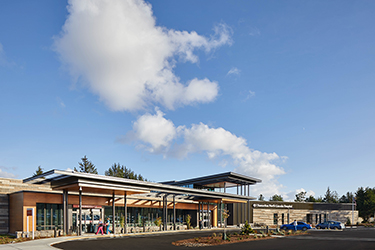|
Subscribe / Renew |
|
|
Contact Us |
|
| ► Subscribe to our Free Weekly Newsletter | |
| home | Welcome, sign in or click here to subscribe. | login |
Construction
| |
 |
April 1, 2022
The challenge of fighting climate change Health
Skanska

Smedley
|
care and sustainability play a?crucial?role in fostering a resilient society?and ensuring a sustainable future. In the face of a disturbance, health care facilities are among the most important components of our community. Be it extreme weather risks, infrastructure disturbances, utility outages, mass casualty events, or a public health crisis, health care facilities must remain available and functional. As such, prioritizing sustainable and resilient design and construction within these facilities is essential.
According to a 2020 Health Affairs study, the health care industry accounts for more than 8% of all U.S. greenhouse gas emissions. In 2021, the U.S. Department of Health and Human Services launched a new Office of Climate Change and Health Equity aimed at protecting community health across the nation and assisting in regulatory efforts to reduce greenhouse gas emissions throughout the health care sector.
And, on the heels of President Biden announcing his goal of creating a net-zero economy by 2050, and local governments making huge strides in regulatory action to fight climate change, we will start seeing all sectors — nationally and locally — ramp up sustainability initiatives.
In alignment with these shared goals and regulations, great strides are being made among our health care clients in both green building and sustainability efforts. Within my role as senior director of sustainability at Skanska USA Building, I advise and collaborate with building owners and designers to determine key sustainability priorities and strategies within the project lifecycle. Among the highest priorities for our industry and our clients is resiliency.
Resiliency can be defined as the intentional design of buildings to respond and plan for natural and manmade disasters and disturbances — as well as long-term changes resulting from climate change. Building resiliency incorporates many components — various energy and water sources, disaster fortitude design, emphasis on passive systems, resource storage, and reduced environmental impacts such as the greenhouse gas emissions associated with construction and operations.
A building is resilient if it maintains functionality in the face of disaster — a vital element in health care facilities. A building is resilient because of its strategic energy recovery systems. A building is resilient if it was built to combat climate change through holistic decarbonization initiatives. A building is resilient if it improves the ability to care for patients in complex situations.
When it comes to resiliency, needs vary by region. For instance, a West Coast client may be concerned with seismic needs. A health system on the Gulf Coast is thinking about hurricanes. All are focused on pandemic and mass casualty preparedness.
The importance of resilient building was emphasized throughout our work on the Samaritan North Lincoln Hospital in Lincoln City, Oregon. For this hospital, operational resiliency, seismic, and economic resiliency were all key factors during design and construction. The facility featured flexible spaces including outpatient and diagnostic imaging rooms that could be transformed into emergency treatment bays and inpatient rooms when needed. As the region anticipates?a potential Cascadia Subduction Zone earthquake, the new facility?had to?be?built to withstand a 9.0 magnitude earthquake. According to the Lund Report,?state engineers?noted the facility sets a new benchmark for earthquake readiness across all buildings in Oregon.
Another key to resilient building is ensuring that project plans will adhere to all future regulations surrounding climate action legislation, which can be hard to predict and vary from state to state. Regardless, embodied carbon regulation is key in meeting long-term decarbonization goals both within our industry and local communities. As part of its sustainability program plan, King County was a pilot partner for the Embodied Carbon in Construction Calculator (EC3), a tool co-created by Skanska and supported by over 50 industry partners that is working to help reduce embodied carbon throughout the built environment.
Additionally, many of our health care clients have made strong carbon reduction commitments that consider both operational and embodied carbon reduction. Utilizing innovative technology like early energy modeling tools and EC3, we can visualize and strategize the use of different materials and methods to reduce a project’s final carbon footprint.
As the climate continues to change and we see the evolution of natural disasters, resiliency must be a top priority when mapping out sustainability initiatives within the construction industry. To successfully do this, it is of course necessary to look to history for lessons learned, but more importantly it is essential to look at predicative data and the future state of our society.
This data, which includes invaluable projections surrounding environmental risks, impending infrastructure hazards, and analysis on population displacement due to climate impacts, allows developers and community leaders to future proof their infrastructure, and plan all future projects through a resiliency lens.
This, combined with a keen understanding and focus on decarbonizing health care facilities to reduce greenhouse gas emissions, is vital to the future of our society and our planet. By focusing on resilience and mitigating climate change via decarbonization, we have the ability to future proof our health care system and ensure its future impact on the environment is a positive one.
Stacy Smedley is Skanska’s senior director of sustainability.
Other Stories:
- A boost for health care education at Bates Tech
- Don’t ignore new compliance requirements
- Designing a healing river in Sequim
- The lab building of the future is NEXT
- What it takes to build health and science projects
- It’s time to rethink health care design
- A cancer care model with all the right amenities




